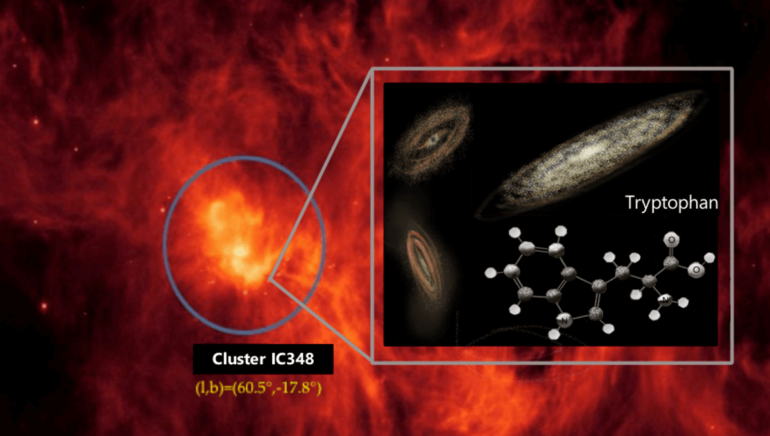Using data from the Spitzer space observatory, Dr. Susana Iglesias-Groth, a researcher from The Instituto de Astrofísica de Canarias (IAC), has found evidence for the existence of the amino acid tryptophan in the interstellar material in a nearby star-forming region. The research is published in Monthly Notices of the Royal Astronomical Society.
High amounts of tryptophan were detected in the Perseus molecular complex, specifically in the IC348 star system, a star-forming region that lies 1,000 light years away from Earth—relatively close in astronomical terms. The region is generally invisible to the naked eye, but shines brightly when viewed in infrared wavelengths.
Tryptophan is one of the 20 amino acids essential for the formation of key proteins for life on Earth, and produces one of the richest pattern of spectral lines in the infrared. It was therefore an obvious candidate to be explored using the extensive spectroscopic database of the Spitzer satellite, a space-based infrared telescope.
The analysis of the infrared light emitted from the region revealed 20 emission lines of the molecule tryptophan. The temperature of the tryptophan is about 280 Kelvin, or 7°C. Iglesias-Groth has previously found water and hydrogen at the same temperatures in IC348.
The study suggests that the emission lines associated with tryptophan may also be present in other star-forming regions and that their presence is common in the gas and dust from which stars and planets form.
Amino acids are commonly found in meteorites and were present during the formation of our solar system. This new work could indicate that these protein-building agents—that are key to the development of life—exist naturally in the regions where stars and planetary systems form, and may contribute to the early chemistry of planetary systems around other stars.
Dr. Iglesias-Groth says, “The evidence for tryptophan in the Perseus molecular complex should encourage additional effort to identify other amino acids in this region, and in other star-forming regions. It is a very exciting possibility that the building blocks of proteins are widely present in the gas from which stars and planets form—it may be key for the development of life in exoplanetary systems.”
More information:
Susana Iglesias-Groth, A search for tryptophan in the gas of the IC 348 star cluster of the Perseus molecular cloud, Monthly Notices of the Royal Astronomical Society (2023). DOI: 10.1093/mnras/stad1535
Provided by
Royal Astronomical Society
Citation:
Evidence of the amino acid tryptophan found in space (2023, June 20)



